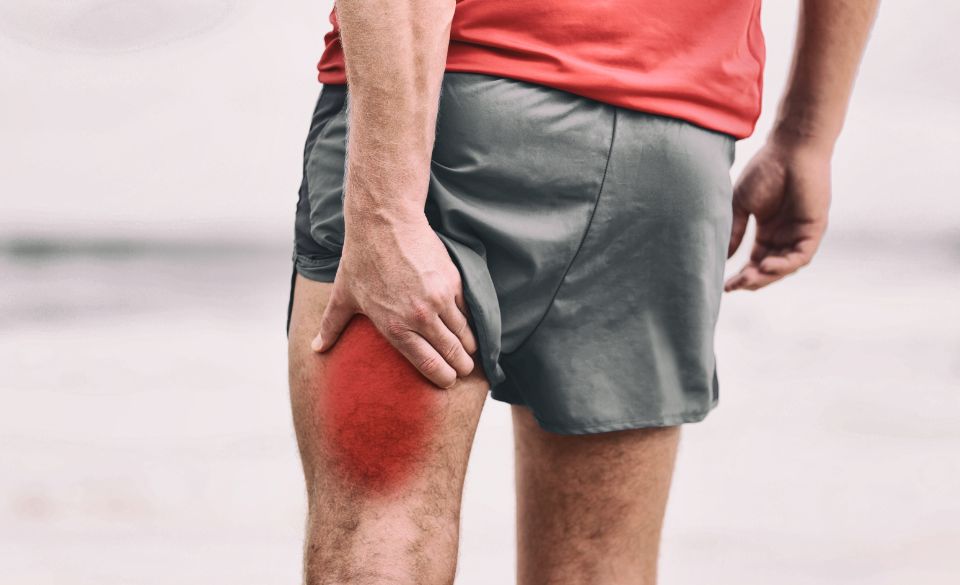
Sore Hamstrings After Running – A Complete Guide
Page Contents
If you’re an avid runner, you may have experienced the discomfort of sore hamstrings after a run. Soreness in the hamstrings, the muscles located at the back of your thighs, is a common issue among runners. It can range from mild discomfort to sharp pain, affecting your running performance and overall comfort. In this article, we will explore the causes of sore hamstrings after running, discuss ways to alleviate the discomfort, and provide tips to prevent hamstring soreness in the future. So, let’s dive in and find out how to deal with those sore hamstrings!
Causes of Sore Hamstrings After Running
Muscle Fatigue: Running puts a significant strain on your hamstrings, especially during long-distance runs or intense workouts. When your hamstrings become fatigued, micro-tears can occur in the muscle fibers, leading to soreness and discomfort.
1. Tightness or Imbalances: Tight hamstrings or muscle imbalances can contribute to hamstring soreness after running. If your hamstrings are already tight or if there’s an imbalance between your hamstrings and other leg muscles, the strain of running can exacerbate the issue and result in soreness.
2. Overuse or Overtraining: Running too frequently or increasing your mileage too quickly without proper rest and recovery can lead to overuse injuries, including sore hamstrings. Pushing your body beyond its limits without adequate time for repair can result in muscle fatigue and soreness.
3.Improper Running Form: Running with improper form, such as overstriding or landing heavily on your heels, can increase the strain on your hamstrings and lead to soreness. It’s important to focus on maintaining good running mechanics to prevent excessive stress on your muscles.
Alleviating Sore Hamstrings After Running
1. Rest and Recovery: Give your hamstrings time to rest and recover. Avoid high-impact activities or intense running sessions until the soreness subsides. Incorporate active recovery activities like gentle stretching, walking, or low-impact exercises to promote blood flow and aid in muscle recovery.
2. Stretching: Perform gentle stretching exercises targeting the hamstrings to alleviate soreness and improve flexibility. Examples include standing or seated hamstring stretches, lying hamstring stretches, or using a foam roller to release tension in the muscles.
3.Massage and Foam Rolling: Massage and foam rolling can help reduce muscle tension and promote blood circulation to aid in recovery. Use a foam roller or massage tools to target the hamstrings and other surrounding muscles.
4. Ice or Heat Therapy: Applying ice or heat to the sore hamstrings can help alleviate pain and reduce inflammation. Ice packs or cold compresses can be applied for 15-20 minutes several times a day, especially in the first 48 hours. Afterward, heat therapy, such as a warm towel or heating pad, can help relax the muscles and promote healing.
Preventing Sore Hamstrings in the Future
1. Proper Warm-up: Always warm up before running to prepare your muscles for the activity. Incorporate dynamic stretches and exercises that specifically target the hamstrings to loosen them up and improve blood flow.
2. Gradual Progression: Avoid sudden increases in mileage or intensity. Gradually progress your running routine to allow your body to adapt and minimize the risk of overuse injuries.
3. Strength Training: Include strength training exercises that target the hamstrings and other leg muscles in your fitness routine. Building strength in these muscles can help prevent imbalances and provide better support during running.
4, Proper Running Form: Focus on maintaining good running form, including a slight forward lean, shorter strides, and a midfoot or forefoot strike. This reduces the impact on your hamstrings and distributes the load more evenly across your leg muscles.
5. Cross-Training: Incorporate cross-training activities into your routine to provide variety and reduce the repetitive strain on your hamstrings. Engage in activities like cycling, swimming, or strength training exercises that target different muscle groups.
6. Proper Footwear: Ensure that you’re wearing appropriate running shoes that provide adequate cushioning and support. Ill-fitting or worn-out shoes can increase the stress on your hamstrings and lead to soreness.
7. Listen to Your Body: Pay attention to any warning signs or discomfort during your runs. If you feel excessive strain or pain in your hamstrings, take a break and allow for rest and recovery. Pushing through the pain can worsen the soreness and increase the risk of injury.
8. Hydration and Nutrition: Stay hydrated and fuel your body with a balanced diet to support muscle recovery and prevent muscle cramps or tightness. Proper hydration and nutrition are essential for overall muscle health.
Remember, everyone’s body is unique, and what works for one person may not work for another. It’s important to listen to your body, adapt your training routine to suit your needs, and seek professional guidance if needed.
Additional Tips for Hamstring Health
In addition to the strategies mentioned earlier, here are a few extra tips to keep your hamstrings healthy and prevent soreness:
1. Regularly Incorporate Strength Training: Including exercises that specifically target your hamstrings in your strength training routine can help improve their strength and endurance. Exercises like deadlifts, glute bridges, and hamstring curls are effective in strengthening these muscles.
2. Maintain Proper Posture: Poor posture can contribute to muscle imbalances and strain on the hamstrings. Pay attention to your posture throughout the day, especially when sitting or standing for long periods. Aim for a neutral spine alignment to reduce unnecessary stress on the hamstrings.
3. Stay Hydrated: Dehydration can lead to muscle cramps and tightness, including in the hamstrings. Ensure you drink enough water throughout the day to stay properly hydrated, especially before and after your runs.
4. Incorporate Active Recovery: On rest days or after a particularly intense run, engage in active recovery activities to promote blood flow and muscle relaxation. Light exercises like gentle walking, swimming, or yoga can help alleviate muscle soreness and promote recovery.
5. Get Regular Sports Massages: Consider incorporating regular sports massages into your routine to relieve muscle tension, improve flexibility, and prevent injury. A professional massage therapist can target your hamstrings and provide deep tissue work to release any tightness or knots.
6. Gradually Increase Intensity and Volume: When you’re ready to increase the intensity or duration of your runs, do so gradually to allow your hamstrings to adapt to the new demands. Pushing too hard or making sudden jumps in intensity can lead to overuse and increased risk of soreness.
Remember, the key to maintaining healthy hamstrings is a combination of proper training, rest, and listening to your body. If you experience persistent or severe pain in your hamstrings, it’s important to seek medical advice to rule out any underlying issues or injuries.
By implementing these additional tips and staying consistent with your hamstring care, you can keep your hamstrings strong, flexible, and ready for your next run.
Summing Things Up
Sore hamstrings after running can be a frustrating experience, but with the right approach, you can alleviate discomfort and prevent future issues. By understanding the causes of soreness, implementing effective strategies for recovery, and taking proactive steps to prevent hamstring tightness and imbalances, you can maintain healthy and pain-free hamstrings.
Remember to prioritize rest and recovery, incorporate proper stretching techniques, and consider alternative therapies like massage or heat therapy to alleviate soreness. Gradual progression, cross-training, and proper form are essential in preventing overuse injuries and maintaining balanced muscle strength.
Additionally, listening to your body, staying hydrated, and fueling yourself with a nutritious diet will support muscle recovery and overall performance. Each runner’s journey is unique, so it’s important to find the strategies that work best for you and adjust your training routine accordingly.
By taking care of your hamstrings and implementing these tips, you can enjoy your running experience to the fullest, free from the discomfort of soreness. So lace up your running shoes, hit the road, and keep those hamstrings happy and healthy!



